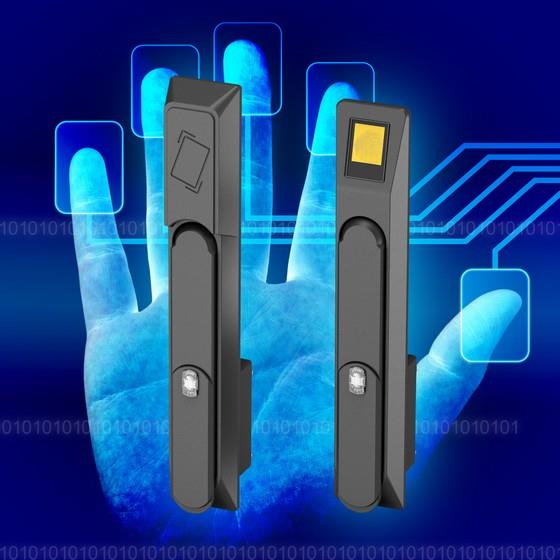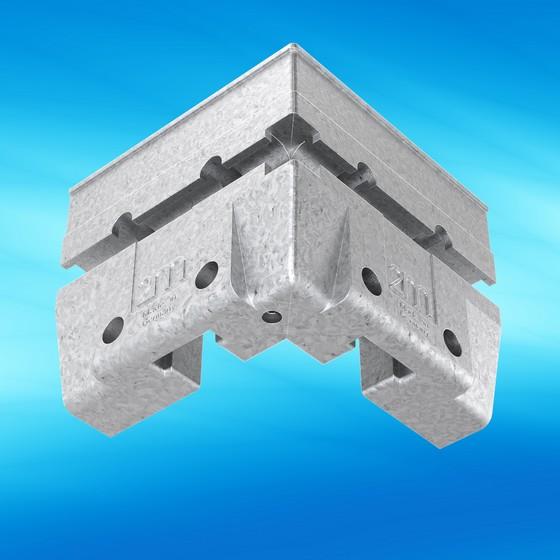Recent rapid developments in locking systems involve a number of high end electronic lock technologies specifically aimed at data centres or co-location environments where data security is a quickly increasing concern.
At the very top end of these security systems is the latest in fingerprint technology – a system developed in conjunction with Digitus-Biometrics to lift modular mechanical locking systems to the level of a fully networked access and monitoring system. This high level security matches with slave units for linked panels plus PIN pad and RFID swipe card modules for three levels of data guarding under the oversight of a remote operator with a networked Cockpit dashboard display.
Such advanced electronics are part of the rapid developments taking  place in the enclosure security market, but it is also important to recognise that gradually over many years, away from the hubbub surrounding revolutionary internet and telecoms technologies, we have seen the quiet development of more diverse technologies in established traditional industries. Evolutionary changes in these long cycle time technologies often go unnoticed but can have very significant implications for our day to day working lives – ranging from ease of use, to reduction in waste and emissions.
place in the enclosure security market, but it is also important to recognise that gradually over many years, away from the hubbub surrounding revolutionary internet and telecoms technologies, we have seen the quiet development of more diverse technologies in established traditional industries. Evolutionary changes in these long cycle time technologies often go unnoticed but can have very significant implications for our day to day working lives – ranging from ease of use, to reduction in waste and emissions.
Engineers at EMKA have the goal to refine designs and manufacturing techniques, in line with customer requirements - balanced alongside materials and production developments derived from wider industry. An excellent example is the specialist area of friction welding where there are only a small number of expert companies across Europe capable of certain high quality work, such as welding of aluminium tube to aluminium casting for an advanced sports car gas damper suspension strut.
These suspension tubes are produced for Bilstein damper units to go on the new BMW i8 electric sports car whose specification includes light weight, limited space and close tolerances of the aluminium used for both the tube and the forged bracket to be attached. Friction welding was considered optimal in this case because of its high strength and consistent blending of both substrate materials throughout the weld, giving an airtight and void free joint.
In addition the production process was simplified and cost reduced since friction welds require no consumables such as filler metal and flux – which also eliminates the need to clean residues from the completed assembly. Friction welding in general has been found to be excellent for the joining of dissimilar metals while minimising the Heat Affected Zone (HAZ) – thus greatly enhancing the designer's ability to optimise material choices and location of joints in the structure.
An aluminium forging and welding capability for automotive engineering led to investment in a more extensive aluminium plant also including casting, pressing and stamping for other components such as decorative interior parts such as gearshift plate, interior handles plus engine/transmission parts such as bearing plates.
 The way these technologies feed each other may be seen in the development of high pressure aluminium die casting which is widely applied to the production of complex bracketry in many areas of industry, because of its ability to produce very accurate, high strength and complex components with a minimum of waste and secondary finishing. Consequently it was an obvious choice when EMKA had the chance to produce complex multifunction corner assembly blocks with locations and fixings for the company 2M Ecke who provided the staging for the 2014 Eurovision Song Contest - and for other large national/ international events.
The way these technologies feed each other may be seen in the development of high pressure aluminium die casting which is widely applied to the production of complex bracketry in many areas of industry, because of its ability to produce very accurate, high strength and complex components with a minimum of waste and secondary finishing. Consequently it was an obvious choice when EMKA had the chance to produce complex multifunction corner assembly blocks with locations and fixings for the company 2M Ecke who provided the staging for the 2014 Eurovision Song Contest - and for other large national/ international events.
Specialist components like these have much in common with enclosure lock bodies and hinges – and with motor vehicle locks, interior fittings or suspension elements. They are required to accept associated bolts and brackets in holes, slots or recesses and to maintain considerable strength as structured elements in the staging which must be quickly and accurately assembled. This puts a premium on consistent tolerances, closeness of fit, integrity and quality of costing, finish re manual handling and ability to work in high tensile material.
By virtue of continuously developing these traditional technologies it has been possible to develop from simple modular cabinet components into more complex items such as compression locks which are also used on motor vehicles and other applications. For example the move into production of enclosure profiles and sealing systems was very applicable to automotive use such as vulcanised rings and corner joints, also PVC and EPDM gluing of joints, production of banding straps and luggage loops. Of course this process works back as well to enhance the quality and expanded functionality of simpler products leading to a more sophisticated range of more developed and basically better products. In fact it is probably true to say that: "Pretty much anything we want to make, we can make."
This includes air conditioning cabinet compression locks for example, a range which expanded into levered latches for commercial vehicle internal panels and external luggage/equipment compartments. Essentially these vehicle components are slightly more complex derivatives of enclosure items. Allied products include toggle fasteners – for military vehicles with storage moved from the inside so increasing internal space and safety of army personnel carriers. Similarly, the 1056 butt hinges – developed with a friction feature, perhaps for glove boxes and windows on commercial vehicles, and rail compression locks, which have been developed with a standout visual indictor such as the high speed dual dust cap, tested to remain in place at 300 KPH but which will not close unless the lock is already securely closed.
Parallel product developments from this ongoing program include stainless steel hinges with retaining pin which allows for hinge removal without loss of pin and extension of lock bodies to suit thicker moulded and composite panels as used on caravans, mobile homes and motor homes. An interesting allied case is that of the niche market for horse boxes, where colour co-ordinated products are often required. The process now uses neutral raw material with add-in colour at the machine so reducing both practical batch sizes and waste. The operation has been made much simpler with advancements in colour change capability during production, especially for polyamide.
Interestingly even traditional electrical control cabinet environments have become much more extreme and we have been able to respond with an expanded range of high grade AISI 316 stainless steel locks and handles for offshore gas fired power stations. These were developed with special silicone seals for high temperature operation where high ambient is experienced in some locations, but more importantly equipment may need to be mounted adjacent to pipework running at combustion related temperatures.
Alongside the metal technologies we have seen tremendous growth in the alternatives such as filled and unfilled plastics – generically these are often known as engineering plastics – developed over recent decades these have offered performance comparable with metal in many situations at a fraction of the cost. EMKA is now in a new wave of development with these materials where their performance is sufficiently advanced to compete head on with metal in even more places, while maintaining advantages in the form of lower cost, light weight and corrosion resistance. The key to taking advantage of these developments lies in understanding their individual properties and matching complimentary materials to a suitable component application and design.
Recent work with new generation advanced plastics make metal replacement an easy option with materials such as the range of EMS Grivory, Grillamid and Grilon high performance polyamides e.g. for our tough low weight hinge for chiller units on trucks. Not only do they present unusually high strength, light weight and ease of use in production – some of these materials work together to confer particularly low friction and thus permit tighter working tolerances with consequent benefits in feel, accuracy of operation and longevity. They are therefore increasingly suited to high stress items and for corrosive environments where otherwise heavier stainless steel would be used at much higher cost of material, wastage and energy input. Advanced engineering plastics also offer the possibility of recycling locally at the machine with much lower resource cost than stainless steel. Their use as injection moulded components of course enables much more complex and refined design forms than would be practical or even possible with stainless steel.
Andy Billingham is managing director of EMKA (UK).










